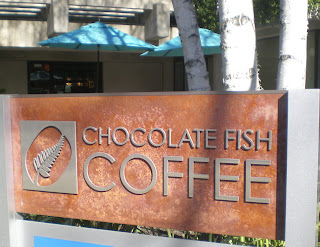Guatemalan Coffee Farm post.
If you haven't stopped into Chocolate Fish Coffee (3rd & Q) then you are missing out on quality coffee, award winning baristas, and coffee education. About once a month CF offers some sort of a coffee class, be it brewing, the story of coffee from farm to table, or coffee tasting - which I went to this weekend.
Coffee tasting is offered to only eight people per class and takes about an hour. For $15 you get the class and then a half pound of coffee of your choice to take home.
 |
| Erik serving up coffees before class. |
I don't want to tell you everything, since you really should go to the class. But I will tell you a few things I came away with. Erik was our teacher for the day with Alfonso prepping the coffee in the back for our blind tasting. Erik started off by going over things that influence coffee taste: climate, soil, etc.
There are two types of varietals of coffee. Arabica coffee is grown at higher elevation, has a lower yield, and slower maturation rate, which equates to more sugar. Robusta beans are grown at a lower elevation, yield more, are often machine harvested, and have more caffeine. Coffee houses generally only use Arabica beans and the Robusta are generally used for mass produced coffees.
After picking the coffee cherries are processed in different ways. There is washing, which is where the fruit is completely removed from the beans. This is what you see in my Guatemala post. There is also the dry method and pulped natural, which "consists of pulping a coffee, but emitting the fermentation stage to remove the silverskin". Usually the processing method depends on the country and the resources they have, such as enough water. Each method imparts different flavor profiles on the coffee.
Another contributor to flavor is the roasting. Roasting changes the sugars and the caffeine. Many coffees are dark roasted, which is more common. CF roasts their coffee medium. Think about sugar when it is cooked goes to caramelized to carbonized (think a toasty brown, caramelized marshmallow versus a burnt, carbonized marshmallow). Also, the lighter the roast, the more caffeine.
Erik then started with the actual tasting. He used a glass dripper, which they sell. After we smelled the coffee grounds, he set them in the dripper. The dripper is conical with cyclone style ridges that help funnel the coffee down the sides. Erik was very precise in the amount of water he poured each time. First he poured about a 1/4 cup to bloom the coffee - an initial release of the CO2 in the grounds and when you get the most powerful hit of aroma. This also soaks the grounds and gets them to "open up" so that they will release more flavor to the water. After about 20 seconds he continued pouring water in a slow, steady stream around the sides of the coffee, not on the paper liner. It took over three minutes for the pour/drip. We all tasted each coffee and used a sheet to note aroma, taste, and mouth feel.
 |
| Glass dripper with cyclone ridges |
The four turned out to be (flavor details here):
1) Guatemalan La Merced - the most popular with the group, washed
2) Brazilian Chapadeo - the most bitter of the group, pulped natural
3) Ethiopian Yirgacheffe - washed
4) Panama Elida Estate - the 2nd most favorite, pulped natural


.png)




